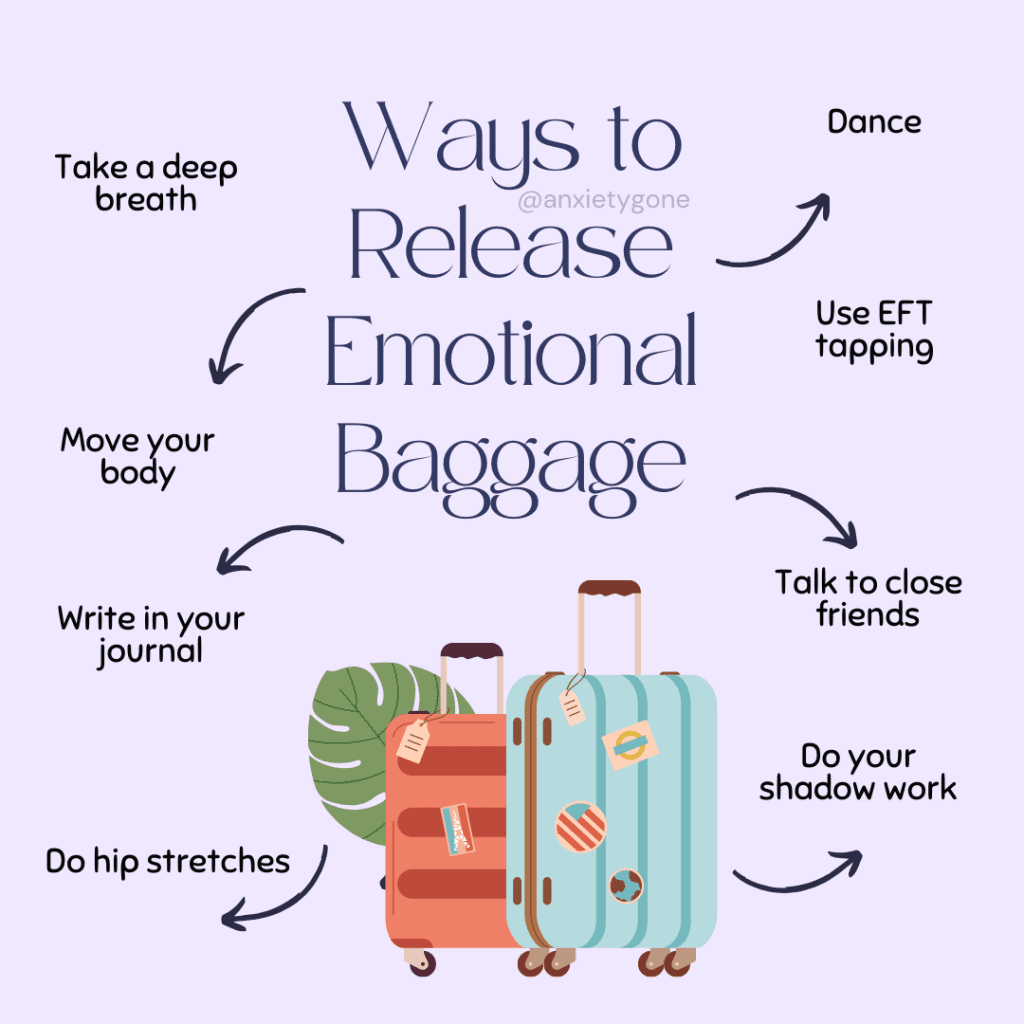Full Disclosure: Clicking on these links could mean a tiny commission for me, at no extra cost to you.
Trauma and old emotional baggage are burdens that many of us carry throughout our lives, often in silence. These hidden wounds can influence behavior, relationships, and our overall mental health well-being. However, we all have the opportunity to release them and lead to profound healing and growth. Sometimes, we just don’t know where to start. So, considering this article your guide to releasing trauma. From trauma release exercises to mental health practices, we have you covered.
Best Ways to Release Trauma and Old Emotional Baggage
- Best for Yoga → Yoga class for trauma
- Best for Dance → Online belly dance class
- Best for Tai Chi → Qigong
- Best for Therapy → BetterHelp
- Best for Somatic Exercises → Amazon
- Best for Psychiatry → Brightside
- Best for Notebooks → Therapy Notebooks
- Best for Mindfulness → Mindfulness App
- Best for EFT → The Tapping Solution
- Best for Trauma Release Exercises → Unlock Your Hip Flexors
- Best for Shadow Work → Amazon
- Best for Breathwork → Inward Breathwork
- Best for Art Therapy → Amazon
Understanding Trauma and Emotional Baggage
Trauma is a response to deeply distressing or disturbing events that overwhelm your ability to cope. It often causes feelings of helplessness, diminishing your sense of self and your ability to feel a full range of emotions and experiences.
Emotional baggage, which is closely related, consists of unresolved emotions and feelings from past experiences. You often end up carrying the weight of these past traumas into present relationships and situations. Emotional baggage also influences how you perceive and interact with the world, often leading to a cycle of negativity and pain that can be hard to break without conscious effort and support.
As you can see, neither are ideal for your mental health.
Recognizing Symptoms and Triggers
Identifying the signs of trauma and emotional baggage is a crucial first step towards healing. Symptoms may include anxiety, depression, flashbacks, and avoidance of certain people, places, or activities that remind one of past trauma. Triggers can also be of the same: people, places, activities, fear of experiencing anxiety, flashes, etc.
Here’s a list of common indicators that someone might be carrying such burdens:
- Persistent Sadness or Depression
- Anxiety and Panic Attacks
- Flashbacks and Nightmares
- Avoidance Behaviors
- Emotional Numbness
- Anger and Irritability
- Difficulty Trusting Others
- Low Self-Esteem
- Substance Abuse
- Physical Symptoms Without a Clear Cause
- Changes in Appetite or Sleep Patterns
- Feeling Stuck or Hopeless
Essential Strategies for Healing
Healing begins with acknowledgment. Recognizing the presence of trauma and emotional baggage and the desire to release these burdens is a pivotal moment in the journey towards wellness. Below, we explore a variety of methods to help you overcome emotional baggage and let go of trauma. From trauma release exercises to professional therapy, there are all kinds of ways you can start healing today.
1. Seeking Professional Help
It only makes sense to start with professional therapy because it is, inarguably, one of the most effective ways to heal. Psychotherapy offers a safe space to explore and understand your emotions and experiences. Therapists can provide strategies to deal with trauma, facilitating healing.
Now, there are various ways you can indulge in therapy. There’s traditional in-person therapy or more modern options, such as online therapy, digital group therapy and DIY therapy workbooks. Here are some of the our top recommendations:
- Best for Availability → BetterHelp
- Best for Couples → ReGain
- Best for Psychiatry → Brightside
- Best for Teens → Teen Counseling
- Best for Anxiety and Depression → Brightside
- Most Affordable → Grouport
- Best for LGBTQIA+ → Pride Counseling
- Best for Notebooks → Therapy Notebooks
- Best for Teen Workbook → Coping Skills for Teens
2. Mindfulness and Meditation
Mindfulness and meditation can help center and calm the mind, making it easier to process and release emotional baggage. These practices encourage presence and awareness, offering a respite from the turmoil of past traumas.
Using mindfulness and meditation to release trauma and emotional baggage involves engaging in practices that help you stay present, observe your thoughts and feelings without judgment, and cultivate a sense of peace and stability. These practices are powerful tools for healing, as they encourage a reconnection with the present moment, often lost in the turmoil of past traumas. Here’s how mindfulness and meditation can aid in releasing trauma and emotional baggage:
- Promotes Present-Moment Awareness
- Reduces Stress and Anxiety
- Enhances Emotional Regulation
- Breaks the Cycle of Negative Thoughts
- Reconnects with the Body
- Encourages Self-Compassion
- Promotes Neuroplasticity
Getting Started with Mindfulness Exercises
For those new to mindfulness and meditation, starting can be as simple as dedicating a few minutes each day to practice. This could involve guided meditations, focusing on the breath, or practicing mindful walking. The key is consistency and patience, as the benefits of mindfulness and meditation accumulate over time.We highly recommend downloading the #1 mindfulness app to receive all of the mindfulness meditations needed along your journey. It is free to use. However, upgrading to the paid version will give you so much more and you can get an exclusive discount here.
Or click here to learn more about the #1 Mindfulness App.
3. Writing and Journaling for Emotional Release
Writing and journaling for emotional release are powerful tools in the journey of healing from trauma and shedding old emotional baggage. These practices offer a private, safe space to express thoughts and feelings that might be difficult to communicate verbally. Here’s how they support emotional release and healing:
- Uncovering hidden emotions, thoughts, and memories
- Clarifying thoughts
- Helps express difficult emotions
- Physical act of letting go
- Problem-solving
- Reframing perspectives
- Building empathy
- Taking control over your stories
- Re-shaping the narrative
- Reducing symptoms of anxiety and depression
Getting Started with Journaling
We highly recommend Therapy Notebooks, created by a collection of professional therapists to assist with DIY therapy.
4. Trauma Release Exercises
Trauma release exercises (TRE) are an effective approach for releasing the deep tension and stress that can accumulate in the body due to traumatic experiences and emotional baggage. These exercises are based on the principle that trauma and stress manifest not only psychologically but also physically, in the form of muscle tightness and various bodily symptoms.
As for the benefits of trauma release exercises for overcoming trauma and emotional baggage, they help with:
- Release deep muscular stress and tension
- Release of emotional tension
- Lower levels of anxiety and symptoms of depression
- Enhanced body awareness
Trauma release exercises offer a unique and effective way to address the physical manifestations of trauma, promoting healing on both a physical and emotional level. By learning to activate and regulate the body’s natural tremoring response, you can release built-up tension, paving the way for a more balanced and resilient state of being.
Getting Started with Trauma Release Exercises
We highly recommend using Unlock Your Hip Flexors, an online program that guides you through releasing tension and trauma stored in your hips.
5. Shadow Work
Shadow work is a profound and transformative approach to personal growth and healing that involves exploring and integrating the unconscious aspects of oneself. Originating from the psychological concepts introduced by Carl Jung, shadow work delves into the parts of ourselves that we’ve rejected, ignored, or denied. These shadow aspects often consist of emotions, desires, and traits that, at some point, we learned were unacceptable or undesirable. Engaging in shadow work allows individuals to confront these hidden parts, leading to a more authentic and whole self.
The process of shadow work starts with recognizing that the shadow exists. This involves acknowledging that there are parts of oneself that have been ignored or suppressed. Then, through various methods such as journaling, meditation, or therapy, you can explore these hidden aspects, understanding their origins and how they’ve influenced behavior and relationships. The last step is not to eradicate these shadow aspects but to integrate them into conscious awareness, allowing for a more balanced and harmonious self. This integration process involves accepting and learning to love all parts of oneself, including those previously judged as negative.
Getting Started with Shadow Work
All you need is a shadow work journal and you’re ready to go. Amazon has all kinds of really great options.
6. Somatic Exercises
Somatic exercises are a therapeutic approach that emphasizes the connection between the mind and body, aiming to relieve tension, stress, and trauma stored within the body’s muscles and tissues. Rooted in the principle that mental and emotional stress can manifest as physical discomfort or dysfunction, somatic exercises involve gentle movements and awareness practices designed to release this stored tension and improve bodily function. Here’s how incorporating somatic exercises can aid in the healing process, particularly for those looking for ways to release trauma and old emotional baggage:
- Reduced Physical Pain
- Improved Mobility and Flexibility
- Enhanced Emotional Regulation
- Increased Self-Awareness and Insight
Getting Started with Somatic Exercises
There are a variety of ways to use somatic exercises. From somatic dvds to somatic therapy workbooks, Amazon has many great options.
7. Emotional Freedom Techniques (Taping)
Emotional Freedom Techniques (EFT), commonly known as tapping, is a therapeutic tool that combines ancient Chinese acupressure and modern psychology with the goal of providing emotional healing and reducing physical discomfort. EFT tapping is based on the premise that imbalances in the body’s energy system are linked to emotional and physical pain, and by restoring balance to this system, you can alleviate symptoms of anxiety, depression, trauma, and emotional baggage.
EFT tapping involves tapping on specific meridian points on the body while focusing on a particular issue or emotion. This process is thought to stimulate the energy pathways, helping to release blockages and restore balance. The tapping sequence you choose can result in:
- Reduce stress and anxiety levels
- Process and release emotional pain from past traumas
- Reduce physical pain
- Improve emotional health
Getting Started with EFT Tapping
EFT tapping can be practiced independently or with the guidance of a certified EFT practitioner. For those new to EFT, it may be beneficial to start with guided sessions to learn the correct techniques and tapping points. The Tapping Solution is a popular app used for at-home tapping practices. And you can get a 14-day free trial here.
9. Intentional Movement
10. Art Therapy
Art therapy allows for the non-verbal expression of emotions and experiences, offering a unique pathway to explore and release emotional baggage. It’s a powerful way to release trauma and old emotions, especially if you find it difficult to articulate your feelings and experiences through words.
In art therapy, you are encouraged to explore their emotions, thoughts, and experiences through art-making under the guidance of a trained art therapist. This process can include drawing, painting, sculpting, and a wide range of other art forms. The art produced becomes a medium through which you can express hidden or difficult emotions, explore their trauma, and begin the process of healing.
Getting Started with Art Therapy
You can also practice art therapy at home, using art kits and workbooks on Amazon.
FAQs
- What is the first step in beginning to heal from trauma and emotional baggage? The first step in healing from trauma and emotional baggage is acknowledging that you are carrying these burdens and recognizing how they impact your life. Acknowledgment paves the way for seeking appropriate support and exploring healing strategies.
- How can psychotherapy help in releasing trauma and emotional baggage? Psychotherapy provides a safe and supportive environment to explore your feelings and experiences related to trauma. A therapist can guide you through various therapeutic approaches, such as cognitive-behavioral therapy (CBT) or EMDR, to help you process these experiences and develop healthy coping mechanisms.
- Are there any specific exercises or physical activities recommended for those dealing with trauma? Yes, activities such as yoga, tai chi, and aerobic exercises like running or swimming can be particularly beneficial. These activities not only improve physical health but also help reduce stress and anxiety, enhance mood, and reconnect the mind and body, which is often needed in trauma recovery.
- Can journaling truly aid in the healing process, and if so, how? Absolutely, journaling acts as a therapeutic tool by allowing you to express emotions and thoughts that may be difficult to articulate verbally. It can help you track your healing journey, understand patterns in your emotional responses, and offer a private space for self-reflection and processing emotions.
- Is it necessary to have a supportive community during the healing process, and why? Having a supportive community or network is crucial during the healing process. Support from others provides emotional comfort, reduces feelings of isolation, and can offer new perspectives and coping strategies. It reminds individuals that they are not alone in their journey and that help and understanding are available.
- How long does it take to heal from trauma and release emotional baggage? The healing process is highly individual and can vary greatly from one person to another. Some may see significant progress in a few months, while for others, it may take years. Healing from trauma is often a gradual process that involves many steps, including setbacks. Patience, self-compassion, and a commitment to the process are key.
Conclusion
Releasing trauma and old emotional baggage is a deeply personal and transformative journey. It requires patience, courage, and support, but the freedom and lightness that come from unburdening oneself are well worth the effort. Embracing the strategies outlined in this article can guide you towards healing, allowing for a more joyful and fulfilled life.














































